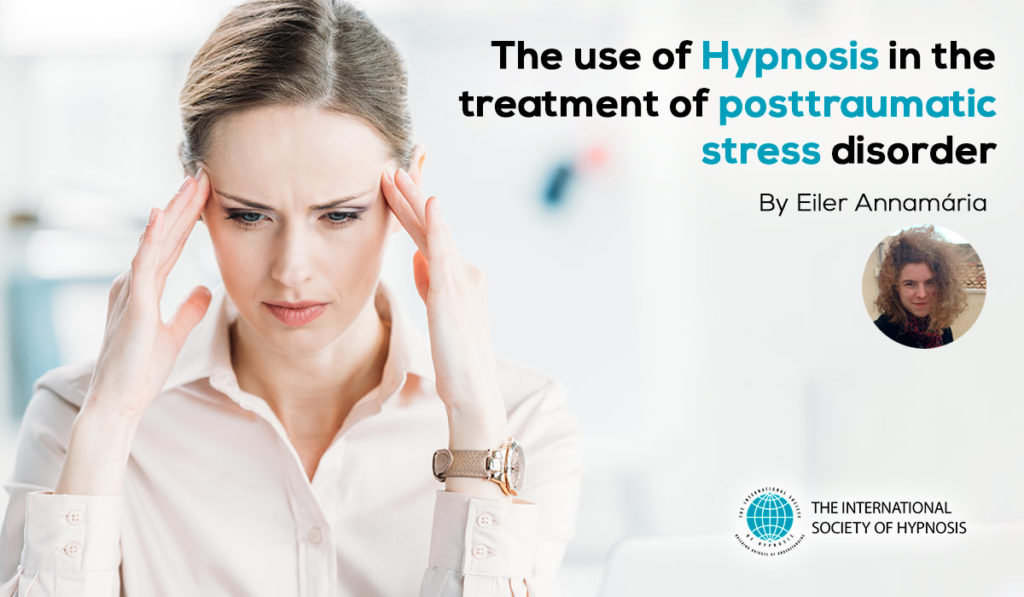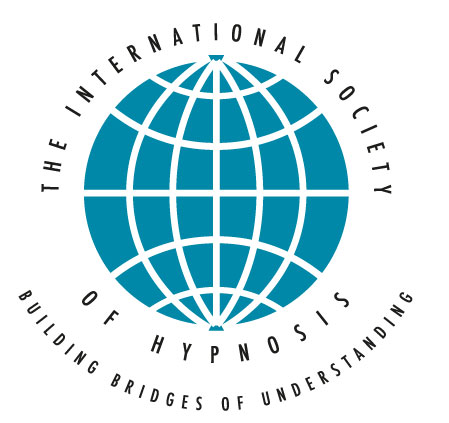

by Eiler Annamária.
INTRODUCTION
Hypnotherapy is one of the oldest treatment methods of traumas in the history of psychology. Though its therapeutic value was already discovered by Freud, it was first widely utilized in the treatment of veterans coming back from Vietnam and struggling with the aftermath of the horrors of war (Ibbotson, 2012). The effectiveness of hypnosis can be explained by the analogy lying between the components of hypnotic state and the symptoms of posttraumatic stress.
According to the DSM 5 categorisation posttraumatic stress disorder (PTSD) falls into the category of Trauma and Stressor Related disorders, but it also has an overlap with dissociative disorders. Dissociation can be defined as a disturbance in the integration of the memory, identity, perception or consciousness: it is usually a natural response to a traumatic and overwhelming experience to protect the self, but it also serves as the basis of altered states of consciousness such as hypnosis (Spiegel & Loewenstein & Lewis-Fernández & Sar & Simeon & Vermetten & Cardeña & Fell, 2011).
SYMPTOMS OF PTSD AND THEIR CONNECTION WITH HYPNOSIS
PTSD consists of four groups of symptoms. Victims may suffer from intrusive thoughts, nightmares and violent flashbacks as they reexperience the traumatic event. Furthermore, they endure hyperarousal symptoms such as hypervigilance, insomnia, concentration difficulties and an overall restlessness. The third characteristic of PTSD is avoidance: the person in question tries to stay away from all stimuli associated with the traumatic event, including people, situations, conversations, the actual place of the event, but also from revisiting the trauma-related thoughts, memories and feelings. Finally, PTSD may lead to the negative alteration of emotional state and cognition: a lack of positive emotions, a negative self-concept and sometimes severe depersonalisation, detachment or even the inability to recall the details of the trauma (American Psychiatric Association, 2013).
All of these overlap with the three main aspects of hypnosis such as absorption, suggestibility and dissociation. Absorption is an intense focus, perception is narrowed both in a hypnotic state and during the trauma or the flashback: the person’s attention is drawn to one particular aspect or detail of the situation while all the others remain unnoticed (Spiegel, 2001). Spiegel defines suggestibility as “a tendency to respond readily and uncritically to social cues” (p. 149). He observes that hyperarousal causes a somewhat similar reaction: PTSD victims usually respond automatically in the traumatic situation and later on they are hypersensitive to cues which may lead to the recollection of the traumatic event.
However, among the three main aspects of hypnosis, dissociation might have the strongest link with PTSD. Spontaneous dissociation in a traumatizing situation is an adaptive and natural self-protective response to cope with the devastating and self-incongruent experience (Spiegel, 1988). It can occur during or after the trauma; rape victims for example may undergo an out-of-body experience during the assault. As the DSM emphasizes, the traumatized can experience dissociative amnesia, detachment and estrangement (American Psychiatric Association, 2013). PTSD can also have comorbidity with dissociative identity disorder, but it is important to note that whereas many DID patients manifest dissociative PTSD symptoms such as amnesia or flashbacks and the problem is also trauma related, numerous features of DID (like dissociated identity states and alternating between them) usually do not occur in PTSD patients (American Psychiatric Association, 2013). While dissociation in PTSD is not deliberate, it is structured and controlled in hypnosis, therefore it can help victims to gain control and re-evaluate the traumatic event (Spiegel, 1988).
To understand dissociation, it is important to know the underlying neurobiological mechanisms of PTSD and the affected brain regions. PTSD patients manifest an excessive activation of the amygdala. When quick reaction is needed, sensorial information gets directly to this region without further cortical evaluation, so the emotional response precedes the conscious judgment. The hippocampus is also involved in the pathopsychology of PTSD, but the recollection of physical responses (such as respiratory and cardiac changes) is mediated by the amygdala (Ibbotson, 2012).
Barabasz and Barabasz state that traumas activate subcortical brain structures, therefore related memories become encoded in these regions. When the traumatic memories are triggered by reminders, the victims manifest an increased cerebral blood flow in particular regions such as the amygdala and the insula, but findings imply that there is a simultaneous deactivation in the left anterior prefrontal cortex, particularly in Broca’s area, which is responsible for the verbal expression of thoughts and emotions (Barabasz & Barabasz, 2013). Thus while those regions which experience strong emotions are activated, the ability to communicate these feelings is reduced. According to these findings, therapy of PTSD cannot simply target the cognitive reframing of the trauma on a conscious level. The authors resorted to the use of abreactive hypnotherapy (reaching the emotional and physical experiences) and found that it had immediate and long-lasting effects on patients suffering from PTSD.
PTSD AND HYPNOTISABILITY
Research implies that PTSD patients have also reportedly high hypnotisability (Spiegel, 1988) (they achieve higher mean score than the normal subjects on the Stanford Hypnotic Susceptibility Scale, Form C). As we have already seen, the victim’s state of mind during or after the trauma resembles considerably the hypnotic state (the attention focus is narrowed, the person experiences dissociation), which influences how these memories are stored and can be retrieved afterwards (Spiegel, 2001). Spiegel draws attention to the fact that the retrieval is facilitated if the person is in a similar buy xanax bar online mental state to the one he or she had when the traumatic event occurred (and the memories were stored), which can be effectively attained by hypnosis. This way PTSD patients can better confront the distressing events and they can gain control over it in a safe and structured way. It is important to note that though dissociative amnesia is a standalone clinical condition in DSM 5, it is also induced by traumatic events and has a comorbidity with PTSD (American Psychiatric Association, 2013). Dissociative amnesia and PTSD also show similar neurocircuitry patterns, and dissociated memories can become briefly available (cf. flashbacks), hence they can be retrieved with hypnosis (Spiegel et al., 2011).
THERAPEUTIC USE OF HYPNOSIS IN THE TREATMENT OF PTSD
There are several adequate forms of hypnosis and therapeutic tools which can be applied in the treatment of PTSD. Hypnosis allows the patient to mobilize his or her resources and slowly integrate and process the trauma. Obviously, the most important step is the creation of a safe environment and an empathic and non-judgemental therapeutic rapport, but after that hypnotherapists can use different methods according to the state and needs of the patient. Dissociation is a possible approach in the treatment of PTSD: therapists may apply dissociated imagery suggestions such as the split-screen technique, the protective bubble or the cinema technique, where the patient can confront the traumatic events and negative emotions without being fully involved (Ibbotson, 2012).
Studies suggest that even a single session procedure can lead to significant improvement. Barabasz and Barabasz used abreactive hypnosis repeatedly in a 5-6 hour long session and found that the consecutive abreactions were experienced less and less intensely. Follow-ups indicated that the positive effects of the treatment were maintained over the course of time (Barabasz & Barabasz, 2013).
Traumas can be confronted with another type of hypnotic induction as well. Active-alert hypnosis induces hypnotic state by suggestions for alertness and mobilization (Banyai & Hilgard, 1976). The person stays physically active, and meanwhile maintains intense mental, physical and emotional focus. The therapist and the PTSD victim then work together to reinforce the person’s sense of inner control. Patients can also learn autosuggestion techniques which can be practiced outside the therapy to reduce the symptoms of PTSD (Eads & Wark, 2015). As helplessness is one of the main features and most devastating elements of traumas, this kind of mental and corporal regulation may help the patient to gain back control and safely explore the consequences of the traumatic event.
Last but not least, hypnosis can also be used as a supportive psychotherapy: Abramowitz et al. applied hypnotherapy in the treatment of combat related PTSD patients who received other types of psychotherapy and medical intervention. Instead of a holistic approach, they concentrated on the treatment of the patients’ PTSD related insomnia and used symptomoriented hypnotherapy. They found that the successful treatment of sleep disturbances improved the victims’ mood significantly and lessened the negative effects of PTSD (Abramowitz et al., 2008).
CONCLUSION
In conclusion, considering the similar underlying mechanisms of posttraumatic stress disorder and hypnosis and the results of empirical studies, we can say that the different forms of hypnotherapy are effective and beneficial treatments, which can help PTSD victims to cope with the distressing symptoms and reframe the trauma, so that it could be integrated into the self without harming the person.
 Annamária Eiler
Annamária Eiler
Eötvös Loránd University
Faculty of Education and Psychology
eiler.marika@gmail.com
Annamária Eiler is currently the student of Eötvös Loránd University. She is in her second year of psychology BA, but previously she graduated also at ELTE from Russian and French language and literature.
In the future, she would like to apply to the faculty of Clinical and Health Psychology of Eötvös Loránd University and study anxiety and trauma or stress-related disorders in particular.
REFERENCES
• American Psychiatric Association (2013): Trauma and StressorRelated Disorders. In Diagnostic and statistical manual of mental disorders (5th ed.)
• American Psychiatric Association (2013): Dissociative Disorders. 2020 Volume 44, No. 4 In Diagnostic and statistical manual of mental disorders (5th ed.)
• Abramowitz, E. G., Barak, Y., Ben-Avi, I., Knobler, H.Y. (2008): Hypnotherapy in the Treatment of Chronic Combat-Related PTSD Patients Suffering from Insomnia: A Randomized, ZolpidemControlled Clinical Trial. International Journal of Clinical and Experimental Hypnosis, 56:3, 270–280
• Banyai, Eva I., Hilgard, Ernest R. (1976): A comparison of activealert hypnotic induction with traditional relaxation induction. Journal of Abnormal Psychology 85(2), 218–224 • Barabasz, A., Barabasz, M. (2013): Hypnosis for PTSD: Evidence Based Placebo-Controlled Studies. Journal of Trauma and Treatment, 4
• Eads, B., Wark, D. M. (2015): Alert Hypnotic Inductions: Use in TreatingCombat Post-Traumatic Stress Disorder. American Journal of Clinical Hypnosis, 58: 159–170
• Ibbotson, G. (2012): Post-Traumatic Stress Disorder (PTSD). In L. Brann, J. Owens, & A. Williamson (Eds.), The handbook of contemporary clinical hypnosis: Theory and practice (pp 389–412). WileyBlackwell
• Spiegel, D. (1988): Dissociation and Hypnosis in Post-Traumatic Stress Disorder. Journal of Traumatic Stress, 1:1, 17–33
• Spiegel, D. (2001): Hypnosis, Dissociation and Trauma. In G. D. Burrows, R. O. Stanley, P. B. Bloom (Eds.), International Handbook of Clinical Hypnosis (pp. 143–158). John Wiley & Sons Ltd
• Spiegel, D., Loewenstein, R. J., Lewis-Fernández, R., Sar, V., Simeon, D., Vermetten, E., Cardeña, E., Dell, P. F. (2011): Dissociative Disorders in DSM-5. Depression and Anxiety, 28, 824–852
